Prepare to be captivated! A thrilling and often mysterious world lies beneath the surface of Oklahoma‘s lakes and rivers. These pristine bodies of water conceal a host of extraordinary creatures, some of which may be dangerous! In this article, we explore the world of predators lurking in the depths of Oklahoma’s lakes and rivers. Get ready to learn about dangerous animals in Oklahoma’s lakes!
Are Oklahoma’s Lakes and Rivers Dangerous?
Oklahoma’s lakes and rivers can be enjoyed safely as long as you respect the wildlife that inhabits these areas. These water bodies are abundant with a diverse range of wildlife, encompassing fish, turtles, and even alligators in specific locations. By treating them with respect, as well as avoiding them, you can minimize any potential dangers.
However, it’s always wise to expect the unexpected. Stay informed, stay cautious, and enjoy the beautiful Oklahoma waterways responsibly.
1. Alligator Snapping Turtle (Macrochelys temminckii)
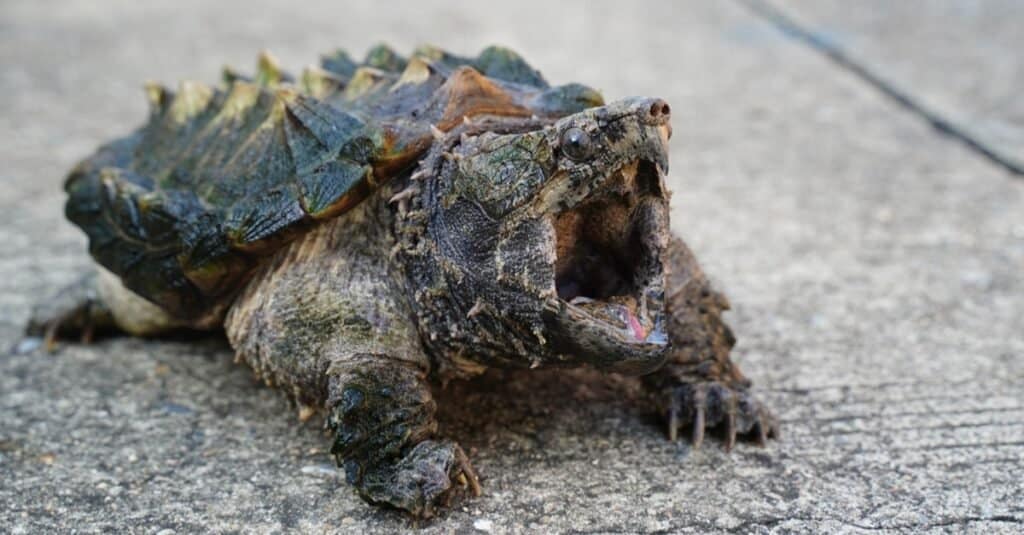
©Sista Vongjintanaruks/Shutterstock.com
The alligator snapping turtle is Oklahoma’s largest turtle and is recognized as the largest freshwater turtle found in North America. Fully grown adults can weigh up to 250 pounds! In Oklahoma, these remarkable creatures are primarily found in the eastern central and southeastern parts of the state. They inhabit lakes, rivers, and sloughs.
Distinguishing features include a hooked beak, three distinct ridges on its shell, and a smooth tail. These characteristics, combined with their impressive size, make it easier to differentiate them from the common snapping turtle.
When left undisturbed in their aquatic habitats, alligator snapping turtles are peaceful and tend to avoid human interaction.
It is essential to exercise caution when dealing with these turtles. They possess a powerful bite that can exert a force of up to 1000 pounds per square inch (PSI). Such a force is capable of snapping through bones! Therefore, it is strongly advised not to handle them in the wild. They can pose a threat to humans if they feel threatened.
Note that powerful bites from these turtles can be dangerous and even life-threatening. They can potentially cause severe bleeding or the loss of an entire finger.
2. American Alligator (Alligator mississippiensis)
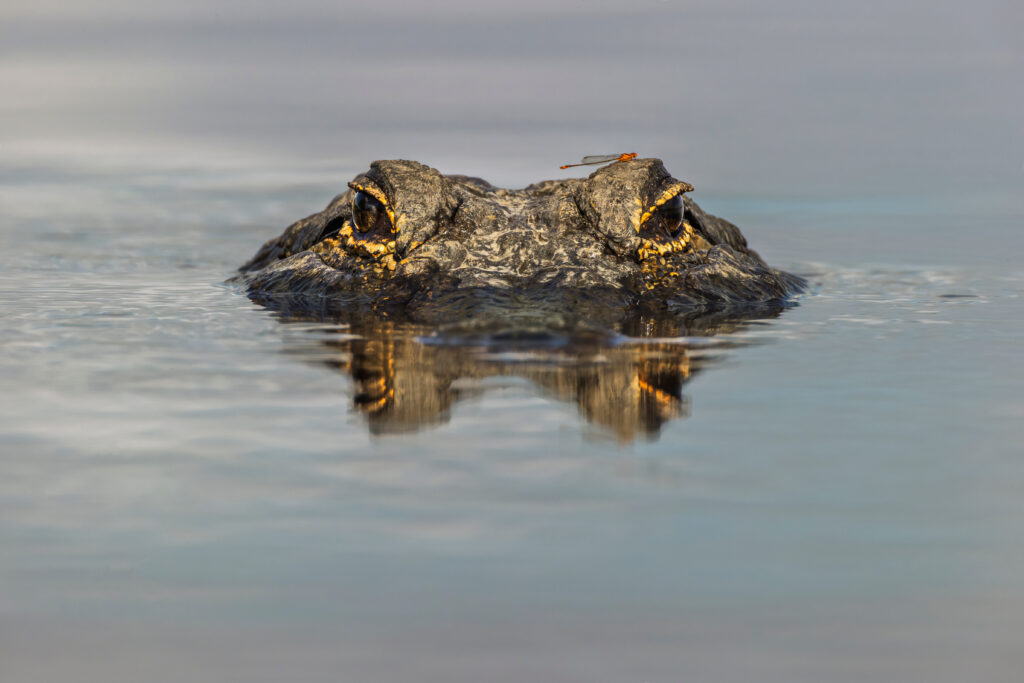
©Danita Delimont/Shutterstock.com
Choctaw County and McCurtain County in Oklahoma have the highest number of these remarkable reptiles. However, these fascinating creatures can also be spotted in various other counties across the region. The alligator community in Oklahoma is estimated to be anywhere between 100 to 200 individuals.
American alligators boast a distinctive appearance. They are characterized by a grayish-black color on their backs and a contrasting lighter shade on their bellies. The young alligators showcase a more vibrant display, sporting hints of yellow and white. Their bodies are well-armored with large, bony plates, providing them with formidable protection. When submerged, the alligators can effectively seal their ears and nostrils using specialized valve-like structures. Fascinatingly, these reptiles can see underwater due to their transparent eyelids.
Amongst the animal kingdom, American alligators possess one of the most powerful bite forces. They exert an astonishing 2000 pounds per square inch. To put that into perspective, a lion’s bite force measures around 600 pounds.
Contrary to common misconceptions, alligators are more inclined to be defensive rather than aggressive. Consequently, the occurrence of alligator attacks on humans is extremely rare. On average, the United States experiences only about six fatal alligator attacks per year. Most of these incidents arise from human encroachment into the alligators’ territory or ill-advised attempts to feed them. These activities cause the animals to feel threatened or provoked.
It’s important to note that bites from crocodiles or alligators can have fatal consequences. Victims lucky enough to survive such encounters face a significant risk of infection.
3. Cottonmouth (Agkistrodon piscivorus)
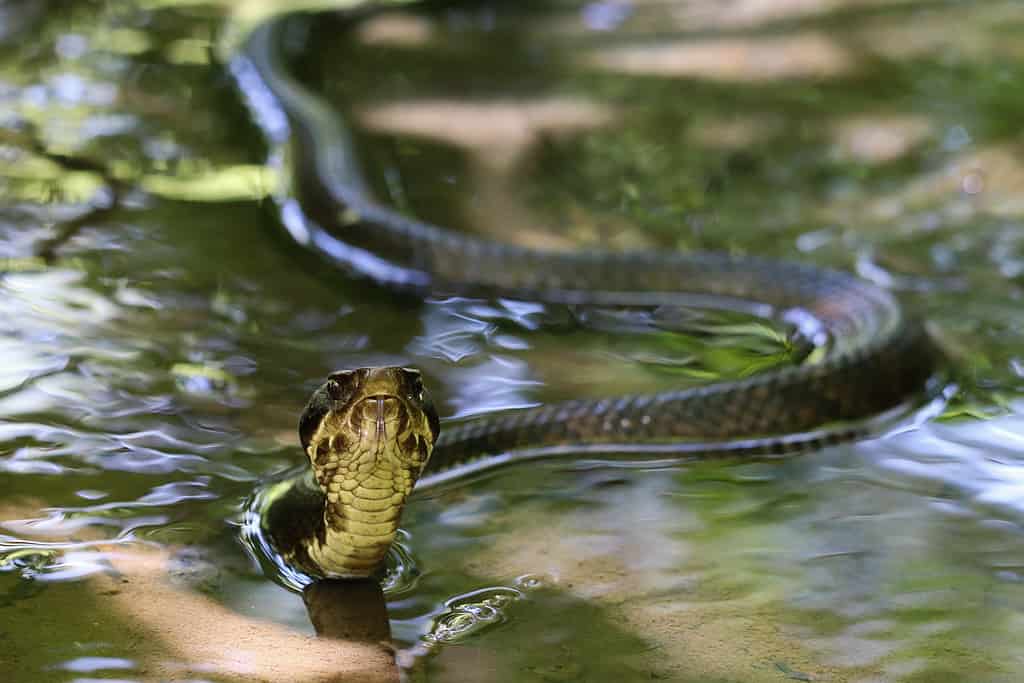
©Rafael R Sandoval/Shutterstock.com
Cottonmouth snakes are primarily found in the southeastern region of Oklahoma and are rarely observed outside of this area.
The cottonmouth snake is a venomous reptile known for its dark, stout, and thick-bodied appearance. When feeling threatened, it opens its mouth wide, revealing a striking white interior, which gives it the name “cottonmouth.” Typically measuring between 30 to 42 inches in length, adult cottonmouths generally have a dark, grayish-brown coloration with minimal or no distinctive patterns.
The frequency of cottonmouth snake bites can vary due to population density and human activity in their habitats. On average, it is estimated that about two to four people are bitten by cottonmouth snakes annually in the United States.
Cottonmouth bites can pose significant risks to both humans and pets, necessitating immediate medical attention from physicians or hospitals experienced in snakebite treatment.
Cottonmouth snakes, by nature, are not aggressive creatures and usually prefer to avoid direct encounters with humans and pets. The majority of snake bites occur when these reptiles are deliberately provoked or unintentionally disturbed through human interaction, such as accidental stepping.
4. Alligator Gar (Atractosteus spatula)
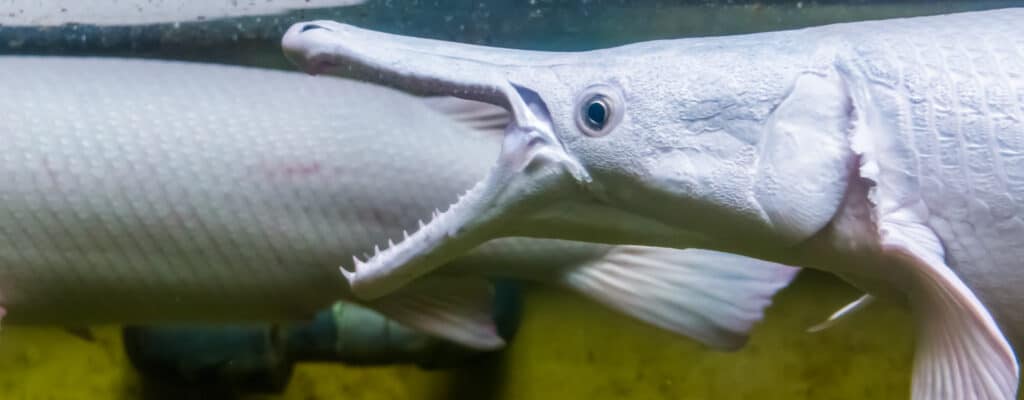
©Charlotte Bleijenberg/Shutterstock.com
In Oklahoma, populations of alligator gar reside in Texoma Lake, as well as the Red River and its tributaries. These fascinating fish have a distinctive appearance with their long, cylindrical bodies and diamond-shaped scales. Sporting a dark olive green color on their upper side and a white underside, they also display dark spots on their dorsal, caudal, and anal fins.
The name “alligator gar” comes from their unique resemblance to crocodiles and alligators, particularly in terms of their head shape and the presence of numerous large teeth.
The teeth of alligator gar are specifically designed for capturing and controlling prey rather than tearing it into smaller pieces like sharks do. As a result, these fish only consume prey that they can easily swallow. While alligator gar can potentially pose a threat to humans due to their large size and sharp teeth, the primary danger arises when anglers attempt to handle these powerful creatures.
Given their size and formidable teeth, it is advisable to exercise caution and avoid direct contact with alligator gar, especially if you are unfamiliar with them.
If you swim in an area inhabited by an alligator gar, remain vigilant of your surroundings. Alligator gar possesses a strong and forceful bite that can cause harm to humans. Their teeth are sharp, and their jaws exert incredible power.
5. Bowfin (Amia calva)
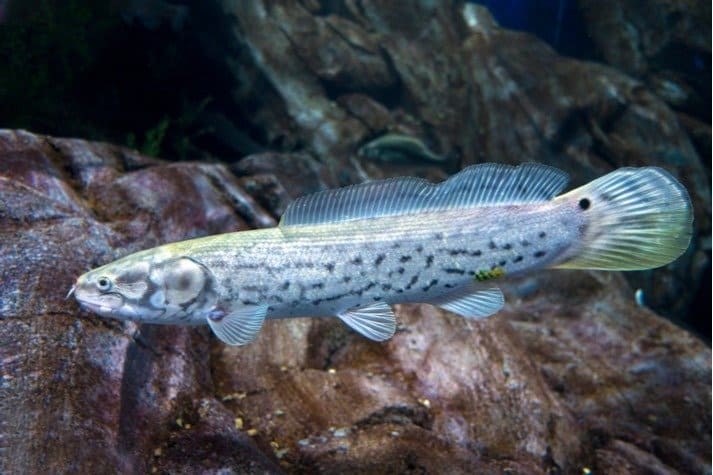
©Miroslav Halama/Shutterstock.com
The bowfin fish can be found throughout the eastern part of Oklahoma, thriving particularly in the abundant waters of Wister Reservoir.
With its beautiful mix of green and brown patterns, the bowfin stands out in appearance, featuring a long dorsal fin and robust conical teeth. Female bowfins can grow up to an impressive length of 30 inches, while the largest individuals can weigh a hefty 21.6 pounds. In comparison, males tend to be smaller, typically reaching a size between 18 and 24 inches. Males also possess a distinctive black tail spot circled with a vibrant orange hue.
Known for its aggressive nature, the bowfin is undoubtedly one of the fiercest predators in the water. It fearlessly attacks anything that moves, showcasing its impressive set of teeth that contribute to its formidable reputation.
The bowfin’s sharp teeth, reminiscent of canines, have the potential to harm human skin. Therefore, unless you possess a protective fur coating like bears and dogs, it’s important to be wary of a bowfin bite. However, with that said, it’s worth noting that while bowfins are indeed predatory fish and have sharp teeth, they are not typically a threat to humans and do not attack people. In fact, they are generally shy and tend to avoid human contact.
If you find yourself bitten by a bowfin, promptly clean the wound using peroxide and running water. While bowfin bites can lead to bacterial infections, it’s crucial to note that they do not contain any venom.
Dangerous Animals Around Oklahoma’s Lakes and Rivers
Let’s have a look at some of the most dangerous animals roaming around near the lakes and rivers of Oklahoma.
1. Timber Rattlesnake (Crotalus horridus)
In Oklahoma, spring and early summer are the best seasons to spot timber rattlesnakes when they are actively moving around.
Similar to other vipers found in North America, timber rattlesnakes possess a wide, flattened head with a distinct triangular shape. Their head showcases beautiful hues of yellow, tan, or gray, often accompanied by a striking dark line extending from each eye to the jaw. The rest of their body may exhibit shades of yellow, tan, brown, or gray, embellished with captivating dark bands encircling their form.
Timber rattlesnakes are venomous, and their bite poses a serious threat to human life. If bitten, immediate medical attention is crucial. Nonetheless, instances of timber rattlesnake bites are infrequent.
Timber rattlesnakes are generally docile and tend to avoid direct encounters with humans and pets. The majority of snake bites occur when people accidentally step on them or intentionally provoke them. Leave these snakes alone!
2. Feral Hogs (Sus scrofa)
Oklahoma has a significant population of wild swine, with estimates placing their numbers at around 1.5 million. These creatures closely resemble domestic pigs but have leaner bodies, coarse bristly fur, and longer tusks. They exhibit a variety of colors and coat patterns due to diverse breeding habits.
These wild pigs pose various threats to both humans and the environment. Not only do they have the potential to attack humans without provocation, causing severe injuries, but they also damage crops and vegetation while foraging. Besides, they can also carry diseases transmittable to humans and other animals.
Historical records indicate that over 100 incidents involving wild pig attacks on humans occurred between 1825 and 2012 in the United States, with five of these attacks tragically leading to fatalities.
If you come across a wild pig, quickly find higher ground for your safety.
3. Mountain Lion (Puma concolor)
While mountain lions are rare in Oklahoma, it’s important to recognize the potential risks they can present.
These majestic creatures exhibit a range of body coloration, from gray to tan. Their adorable cubs often feature blackish-brown spots. Adult males can grow to be more than 8 feet in length and weigh between 115 and 220 pounds.
Mountain lions are formidable predators capable of taking down prey larger than themselves, showcasing their immense strength. A single powerful bite to the throat from a mountain lion can be fatal for both animals and humans alike.
It is crucial to understand and respect the potential danger these creatures pose, especially when venturing into their territory.
4. American Bison (Bos bison)
In the state of Oklahoma, you can encounter the remarkable American bison, a prominent wild animal found in the region.
They possess a distinctive hump over their front shoulders, with their hindquarters appearing more streamlined. Both male and female bison feature a singular set of short, hollow horns that curve outward and upward from the sides of their massive heads.
While they may not instill fear like tigers or mountain lions, bison are unpredictable and may attack suddenly.
With the ability to reach speeds of up to 35 miles per hour, they possess remarkable agility in responding to perceived threats. During an attack, bison can employ their impressive horns, which can grow up to 2 feet long, to gore their target.
Although bison will defend themselves and may attack humans when provoked, such incidents rarely prove fatal, despite resulting in serious injuries. Given that bison are the largest land mammals in the United States, they are undoubtedly capable of causing harm to humans. Nevertheless, experts posit that bison attacks are typically a warning rather than a deliberate intent to kill.
The post Beware of These 5 Dangerous Animals Found in Oklahoma’s Lakes and Rivers appeared first on AZ Animals.
from Animal News, Facts, Rankings, and More! - AZ Animals https://ift.tt/kVZ3dCp